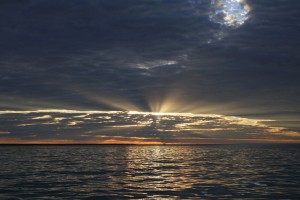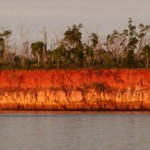Broome → Broome.
Broome is a pearling and tourist town in the Kimberley region of Western Australia, 2200 km north of Perth. The year round population is approximately 14,000, growing to around 30,000 during the tourist season. Broome International Airport provides transport to several regional and domestic towns and cities.
Broome is situated on the traditional lands of the Jukun and Yawuru people.
The first European to visit Broome was William Dampier in 1688 and again in 1699. Many of the coastal features of the area are named by him. In 1879, Charles Harper suggested that the pearling industry could be served by a port closer to the pearling grounds and that Roebuck Bay would be suitable. In 1883, John Forrest selected the site for the town, and it was named after the Governor of Western Australia, Sir Frederick Broome.
In 1889, a telegraph undersea cable was laid from Broome to Singapore, connecting to England. Hence the name Cable Beach given to the landfall site.
The town has an interesting history based around the exploits of the men and women who developed the pearling industry, starting with the harvesting of oysters for mother of pearl in the 1880s to the current major cultured pearl farming enterprises. The riches from the pearl beds did not come cheap, and the town’s Japanese cemetery is the resting place of more than 900 Japanese divers who lost their lives working in the industry. Many were lost at sea and the exact number of deaths is unknown.
The Japanese were only one of the major ethnic groups who flocked to Broome to work on the luggers or the shore based activities supporting the harvesting of oysters from the waters around Broome. They were specialist divers and, despite political pressure to expel them in support of the White Australia Policy, became an indispensable part of the industry until World War II.
Broome was attacked by Japanese aircraft on March 3, 1942. The air raid killed at least 88 people. Following the end of the war in 1945, the town and its pearling industry gradually recovered from the disruptions of wartime.
The West Australian mining boom of the 1960s, as well as the growth of the tourism industry, also helped Broome develop and diversify. Broome is one of the fastest growing cities in Australia.
At Gantheaume Point and 30 metres out to sea are dinosaur footprints believed to be from the Cretaceous Age approximately 130 million years ago. The tracks can be seen only during very low tide.





